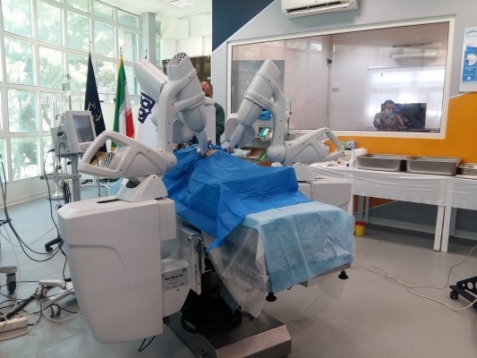According to Sina Press, yesterday, the first remote surgery of the Iranian robot was performed which was a dog vasectomy in two hospitals of Sina and Imam Khomeini.
This robot with the ability to perform remote surgery, after the American models, is the second example in the world.
Alireza Mirbagheri, a member of the faculty of Tehran University of Medical Sciences and CEO of Sina Innovators Robotics and Medicine Company and also the creator of Sina Robot, said in an exclusive interview with Sina Press: "The robot is consisting of two parts. He explained how the surgeon and the robot coordinate from a distance: Every movement of surgeon's hands in the surgical console is performed simultaneously by the surgeon robot on the patient's body. Surgery consoles and surgical robots are connected via Internet."
According to him, the work done by the Sina robot was performed through the Internet connection of Hamrah e Aval platform (Mobile Telecommunication Company of Iran), in the distance of 7 km where the surgeon was located in Sina Hospital and the robot in Imam Khomeini Hospital.
He continued: The production process of this robot took years. The research and development phase of this project started in 2006 and several samples were made. The project is currently in the preclinical and animal studies phase. Previously, the Sina robot had performed surgery with its robotic arms, and this is the first time it has experienced remote surgery.
Mirbagheri stated that remote surgery by a robot is performed in the country for the first time, which previously was owned by the United States. The American robot has been in the market for many years and has performed several surgeries. This technology was uniquely owned by the United States for about 20 years, but today we have succeeded in localizing this device and even its patents have been registered in different countries.
He pointed to the advantages of this robot: “Every movement that the surgeon's hands perform, the robot also performs immediately inside the patient's body, eliminating the surgeon's hand vibrations. Moreover, the movements are scaled in a way that if the surgeon moves his hand one centimeter, the surgeon's robot moves one millimeter inside the patient's body, and thus, reduces the movement errors by one-tenth with greater accuracy.”
He also emphasizes that the robot is capable of carrying complex operations with laparoscopic and closed surgery methods. He continues: "Robotic tools are 5 mm that enter the body through a slit and able to perform large operations easily.
"This remote surgery is performed with an internet connection, but to prevent disruptions and disconnection of telecommunication lines, several internet platforms and telecommunication connections were foreseen during the surgery, so in case of possible problems, we could switch to another connection without disruption. In case of disconnection, surgical arms will be frozen and can be easily detached from the patient."
Mirbagheri believes these types of operations are very popular since the surgeon can sit resulting in less stress and greater accuracy.
He said: "Perhaps one of the advantages of this domestically made robot compared to its American competitor is its price difference." According to him, the price of the Sina robot is approximately one-third of the American model which makes it very attractive for developing countries.
He explains the range of surgeries performed on the robot: All laparoscopic surgeries on the abdomen, pelvis, and chest can be performed with this robot. Reducing bleeding, recovery time and the occupancy of hospital beds are some of the advantages of using Sina robot in surgery.
This project will continue in the future and the robot will enter the phase of clinical studies and service in hospitals.

